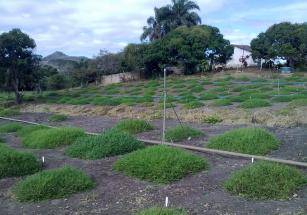Characterization and valuation of Cynodon sp. accessions regarding genetic divergence for defining pre-breeding and genetic breeding actions
Characterization and valuation of Cynodon sp. accessions regarding genetic divergence for defining pre-breeding and genetic breeding actions

Photo: Benites, Flávio
Among the existing grass as alternatives to pasture-based production, the genus Cynodon (stargrass and bermudagrass) has advantages such as high productivity and forage quality, responsiveness to fertilization, resistance to cattle trampling, adaptability to a wide range of soil and climate conditions, and good tolerance to waterlogging and low temperatures. These factors distinguish Cynodon from other grasses predominant in tropical conditions and justify considering such species as a promising alternative for those seeking efficiency in dairy farming through sustainable intensification of dairy production. The varieties of Cynodon grown in Brazil were all developed for temperate conditions and introduced in Brazil by farmers, without being assessed and validated by national research institutes regarding adaptation to our tropical conditions. The foraging potential of Cynodon was evaluated in a Symposium held in Juiz de Fora - MG, in the 1990s and one of the conclusions was that the genetic improvement of species and hybrids of Cynodon in Brazilian environmental conditions could produce new lines of cultivars with desirable characteristics. Embrapa Dairy Cattle made the introduction of forage accessions of the genus Cynodon provided by the USDA, for the purpose of implementation of a breeding program of the species. The objective of this project is to evaluate 41 accessions having sexual and asexual multiplication, from many species of Cynodon, regarding the characterization and evaluation of such accessions in activities of a breeding program. The accessions are being characterized molecularly, cytogenetically, and evaluated in relation to biotic (spittlebug) and abiotic (aluminum toxicity) stresses, agronomically and nutritionally. The results of the characterizations and evaluations carried out will provide basis relative to genetic diversity and potential of the accessions to be included in breeding actions and activities, such as parent selection (as related to genetic divergence, ploidy level, tolerance-resistance to biotic and abiotic stresses, agronomic and nutritional potentials), and methods for growing the populations. These actions for characterizing the introduced accessions are allowing Embrapa to implement the first Cynodon breeding program for tropical conditions. This breeding program aims to develop varieties of Cynodon that meet the demands of farmers on solving the problems shown by the varieties grown in our country (i.e. susceptibility to spittlebug and to soils with high aluminum content) and show adaptation to the various edaphic and climatic Brazilian conditions.
Ecosystem: Atlantic Forest
Status: Completed Start date: Sun Dec 01 00:00:00 GMT-03:00 2013 Conclusion date: Wed Nov 30 00:00:00 GMT-03:00 2016
Head Unit: Embrapa Dairy Cattle
Project leader: Flavio Rodrigo Gandolfi Benites
Contact: flavio.benites@embrapa.br
Keywords: melhoramento forrageiro, diversidade
